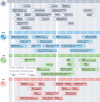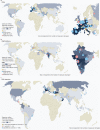COVID-19-associated fungal infections
- PMID: 35918423
- PMCID: PMC9362108
- DOI: 10.1038/s41564-022-01172-2
COVID-19-associated fungal infections
Abstract
Coronavirus disease 2019 (COVID-19)-associated invasive fungal infections are an important complication in a substantial number of critically ill, hospitalized patients with COVID-19. Three groups of fungal pathogens cause co-infections in COVID-19: Aspergillus, Mucorales and Candida species, including Candida auris. Here we review the incidence of COVID-19-associated invasive fungal infections caused by these fungi in low-, middle- and high-income countries. By evaluating the epidemiology, clinical risk factors, predisposing features of the host environment and immunological mechanisms that underlie the pathogenesis of these co-infections, we set the scene for future research and development of clinical guidance.
© 2022. Springer Nature Limited.
Conflict of interest statement
M.H. has received funding from the NIH, Astellas Pharma, Pfizer, Gilead Sciences, MSD, F2G, Euroimmun and SCYNEXIS. A.S.I. received funding from Astellas Pharma, Gilead Sciences and Pfizer and owns shares in Vitalex Biosciences, a start-up company that is developing immunotherapies and diagnostics for mucormycosis.
Figures





